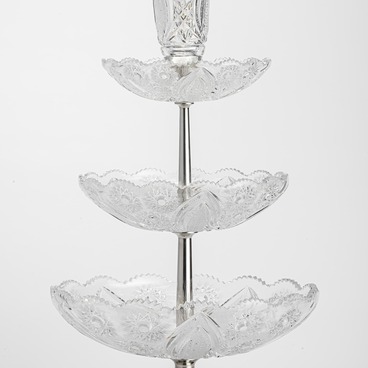The scales on display were created as a decorative item and have never been used for weighing. The history of creation and the symbolic meaning of the scales are of greater value than their functionality.
The third hereditary owner of the glass factory, Aleksey Nikolaevich Bakhmetev, was childless. Thus, after his death, the factory was to be divided among the children of Aleksey Nikolaevich’s married sisters. Bakhmetev understood that such a redistribution of property could destroy the enterprise. Therefore, he left a will, in which he bequeathed the factory to his great-nephew Alexander Dmitrievich Obolensky.
In the spring of 1861, Bakhmetev died. In the summer of the same year, the heir arrived in the village of Nikolskoye — he was only 14 years old at that time. He got acquainted with the workers of the plant who gave him this souvenir.
It was not until 1884 that Prince Obolensky was to return to the factory as an rightful owner. By that time he had been married, had graduated from Moscow University and was a statesman. From his youth he studied crystal and glass business and during the time of his management he improved and expanded the factory production and was the chairman of the Congress of Glassmakers. It was at that time that the factory products were awarded the Large Gold Medal at an international exhibition in Paris. According to information for 1914, the annual turnover of the enterprise was 800,000 rubles. Obolensky paid attention to the cultural education of his workers. Performances were staged in the village of Nikolskoye, and when the factory management building was rebuilt, the design included a theater that could accommodate 400 viewers. In addition, he continued to collect the best examples of Russian and European glass and crystal.
In his memoirs, Obolensky’s youngest son, Pyotr Alexandrovich, recounts a memorable episode. Prince Alexander Obolensky died in Yessentuki on November 26, 1917, when revolutionary movements were already taking place in Russia. Nevertheless, a delegation of workers arrived from the village of Nikolskoye to Yessentuki to say goodbye to the last factory owner, whose management led to the rise of Nikolskoye glassmaking at the turn of the century.
Scales symbolize balanced decisions, honesty and decency, but at the same time it is a functional device. The wooden bottom of the glass case rests on metal ball legs. Inside there is a working mechanism; the pointers are covered with a glass cap. The round dishes are pressed from durable colorless crystal.
There is a matte inscription engraved on the side of the scales. It reads,
The third hereditary owner of the glass factory, Aleksey Nikolaevich Bakhmetev, was childless. Thus, after his death, the factory was to be divided among the children of Aleksey Nikolaevich’s married sisters. Bakhmetev understood that such a redistribution of property could destroy the enterprise. Therefore, he left a will, in which he bequeathed the factory to his great-nephew Alexander Dmitrievich Obolensky.
In the spring of 1861, Bakhmetev died. In the summer of the same year, the heir arrived in the village of Nikolskoye — he was only 14 years old at that time. He got acquainted with the workers of the plant who gave him this souvenir.
It was not until 1884 that Prince Obolensky was to return to the factory as an rightful owner. By that time he had been married, had graduated from Moscow University and was a statesman. From his youth he studied crystal and glass business and during the time of his management he improved and expanded the factory production and was the chairman of the Congress of Glassmakers. It was at that time that the factory products were awarded the Large Gold Medal at an international exhibition in Paris. According to information for 1914, the annual turnover of the enterprise was 800,000 rubles. Obolensky paid attention to the cultural education of his workers. Performances were staged in the village of Nikolskoye, and when the factory management building was rebuilt, the design included a theater that could accommodate 400 viewers. In addition, he continued to collect the best examples of Russian and European glass and crystal.
In his memoirs, Obolensky’s youngest son, Pyotr Alexandrovich, recounts a memorable episode. Prince Alexander Obolensky died in Yessentuki on November 26, 1917, when revolutionary movements were already taking place in Russia. Nevertheless, a delegation of workers arrived from the village of Nikolskoye to Yessentuki to say goodbye to the last factory owner, whose management led to the rise of Nikolskoye glassmaking at the turn of the century.
Scales symbolize balanced decisions, honesty and decency, but at the same time it is a functional device. The wooden bottom of the glass case rests on metal ball legs. Inside there is a working mechanism; the pointers are covered with a glass cap. The round dishes are pressed from durable colorless crystal.
There is a matte inscription engraved on the side of the scales. It reads,





